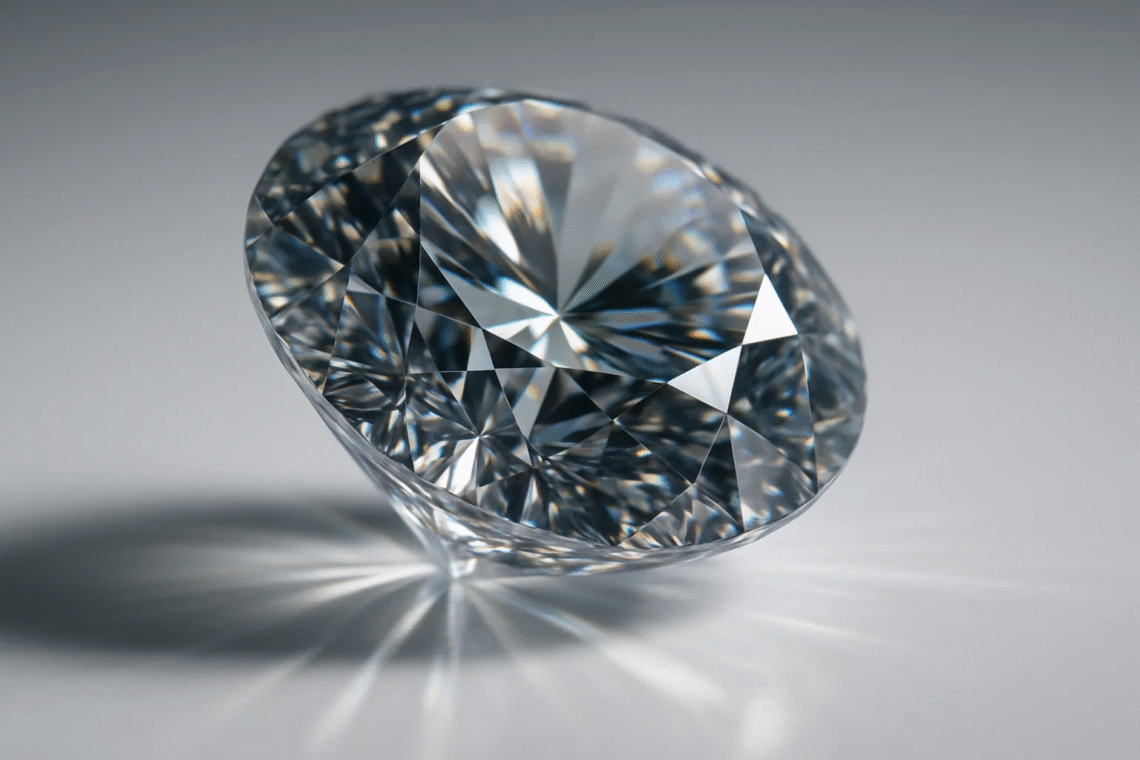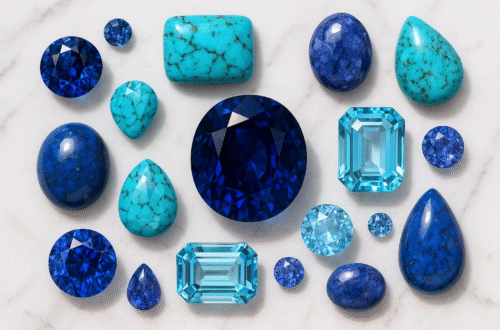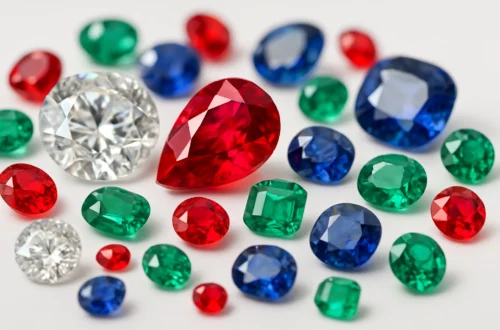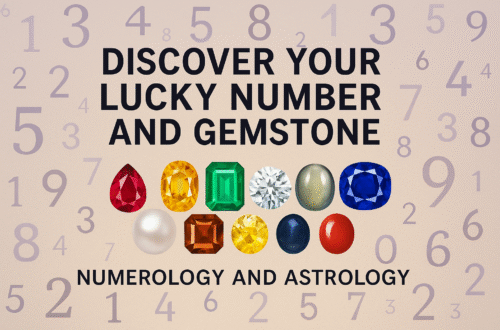Light bends as it enters a gemstone, revealing secrets only a trained eye can decode. The refractive index of gemstones measures this bending, acting as an optical fingerprint that separates ruby from garnet or diamond from cubic zirconia. Some gems allow light to pass through in a single direction, while others split it into two separate rays, creating unique visual effects.
This fundamental difference between single and double refraction shapes how gemstones sparkle, how cutters design facets, and how gemologists confirm authenticity. Whether you’re studying gemology or choosing stones for jewelry, understanding refractive index will sharpen your eye and deepen your appreciation for what makes each gem optically unique.
At Pretty Facets, we believe every gemstone tells its story through light, and understanding how refraction works helps you see that story clearly.
What Is Refractive Index?
The refractive index of gemstones measures how much light slows and bends as it enters a stone from air. This property, typically ranging from 1.43 to 2.42, determines brilliance and fire. Diamond’s high refractive index of 2.42 gives it unmatched sparkle, while quartz at 1.54 produces a gentler glow.
In gemology, the refractive index of gemstones is a vital identification tool, as each mineral has a unique range. It reveals how light travels within a gem, interacts with facets, and defines the beauty that makes each stone visually distinct.
Crystal Systems and Refraction Types
Isotropic vs Anisotropic Crystals
A gemstone’s internal atomic arrangement determines whether it exhibits single or double refraction. Crystals fall into seven systems based on their symmetry, but for optical purposes, they are divided into two groups: isotropic and anisotropic.
Isotropic crystals, found in the cubic system, have uniform atomic spacing in all directions, so light travels at the same speed regardless of its path. Anisotropic crystals, which include all other systems, have varying atomic densities along different axes, causing light to split.
Uniaxial and Biaxial Systems
Within anisotropic gems, tetragonal and hexagonal systems are uniaxial (one special axis), while orthorhombic, monoclinic, and triclinic are biaxial (two special axes). Diamond’s cubic structure makes it isotropic and single refractive, while sapphire’s hexagonal symmetry creates uniaxial double refraction. This structural difference isn’t just academic, it affects everything from how you test a stone to the visual effects it displays under magnification.
Single Refractive Gemstones
Single refractive gemstones allow light to pass through as one unified ray, moving at the same speed in every direction. Diamond, spinel, and garnet are classic examples, each crystallizing in the cubic system. Under magnification, their facet edges appear sharp and singular, never doubled, and a refractometer shows only one RI reading because no light splitting occurs.
This optical behavior produces clean brilliance without the color shifts seen in double refractive gems. In gemstone identification by refractive index, observing a single RI value and no facet doubling usually indicates a cubic system stone, though confirming with specific gravity or spectroscopy ensures accuracy.
Double Refractive Gemstones
Double refractive gemstones split incoming light into two rays traveling at different speeds, each taking a distinct path through the crystal. This phenomenon, called birefringence, occurs in all non-cubic crystal systems.
The difference between the two refractive indices is measured as the birefringence value. For example, zircon shows strong birefringence at 0.059, while sapphire displays moderate birefringence at 0.008. This behavior is one of the key optical properties of gemstones, influencing how they display brilliance, color variations, and internal reflections that make each gem visually unique.

Measuring Refractive Index of Gemstones
Gemologists at Pretty Facets often rely on precise RI readings to distinguish between similar-looking gems like sapphire and spinel. The process requires careful technique and proper equipment to achieve accurate results.
A gemologist’s refractometer measures refractive index in gemstones by detecting the critical angle where light reflects internally rather than passing through. Place a small drop of high-RI contact liquid on the refractometer’s hemispherical glass prism, then position your gemstone’s flat, polished facet down into the liquid. Look through the eyepiece while using the built-in light source, and you’ll see a shadow edge on the scale that corresponds to the gem’s RI.

Using Refractive Index in Gemstone Identification
Cross-referencing your RI reading with a gem refractive index chart offers a strong starting point for identification. A range of 1.76–1.77 could indicate spinel (single refractive) or sapphire (double refractive), making birefringence testing essential. Combine RI results with pleochroism sapphire shows color shifts, while spinel does not. Gemstone identification by refractive index works best when supported by other tests such as specific gravity, inclusion analysis, and color zoning. Since natural and synthetic stones can share identical optical properties, multiple checks ensure accurate results.
Blue sapphires from Sri Lanka, whether natural or lab-grown, will show the same RI of 1.762-1.770, so inclusion patterns and growth features become decisive. Just as numerology can guide gemstone selection for personal energy, systematic testing helps professionals make confident identifications.
Why This Matters Beyond Numbers
The refractive index of gemstones governs brilliance and sparkle, making it far more than an identification factor. A higher RI bends light more sharply at facet junctions, boosting internal reflection and brightness. Diamond’s RI of 2.42 enables cutters to achieve maximum brilliance through total internal reflection, while sapphire’s lower RI of 1.76 requires different cutting angles for the best effect.
This difference explains why some gems shine at shallow pavilion angles while others need deeper cuts. Gemology refractive index also influences light dispersion and fire, helping designers and collectors anticipate how each gemstone will perform under varied lighting.
Common Mistakes and Pitfalls
Testing Technique Errors
- Poor contact between the gemstone and refractometer prism causes the most frequent errors. Always use enough contact liquid to eliminate air gaps.
- Measuring on scratched or frosted surfaces scatters light and produces fuzzy, unreliable readings.
- Internal strain in some gems, particularly synthetic or heat-treated stones, can create anomalous double refraction in normally single-refractive materials.
Interpretation Challenges
- Many gem species have overlapping RI ranges: hessonite garnet (1.74-1.76) and spessartine garnet (1.79-1.81) both fall within ranges that overlap with other species.
- Don’t rely on RI alone for final identification, always verify questionable readings with additional tests like specific gravity or spectroscopy.
- Composite stones or doublets may give misleading results if you accidentally measure the wrong layer.
Conclusion About the Refractive Index of Gemstones
The refractive index of gemstones remains your most accessible and reliable optical testing method, revealing whether light travels through a stone as one ray or splits into two. Mastering the distinction between single and double refraction gives you immediate classification power, narrowing hundreds of gem possibilities down to manageable groups. Combined with birefringence measurements and supporting tests, RI becomes the foundation of systematic gemstone identification.
At Pretty Facets, we encourage enthusiasts to build skills through consistent testing and observation. Explore more gemstone education guides on Pretty Facets to deepen your understanding of gem optics, brilliance, and natural beauty.
Frequently Asked Questions About Refractive Index of Gemstones
What does the refractive index of gemstones actually measure?
It measures how much light slows down and bends when entering a gemstone compared to air, revealing the gem’s optical character and helping identify the species.
Which gemstones are single refractive?
Diamond, spinel, and garnet are classic single refractive gemstones because they crystallize in the cubic system, producing one refractive index reading.
How can I tell if a gemstone is double refractive?
Look for facet doubling under 10x magnification or test with a refractometer where double refractive gems show two distinct shadow edges instead of one.
Why is refractive index important in jewelry design?
A gemstone’s RI determines its potential brilliance by controlling how light reflects internally, guiding cutters in selecting angles that maximize light return and sparkle.





